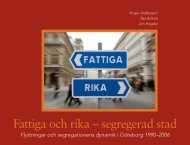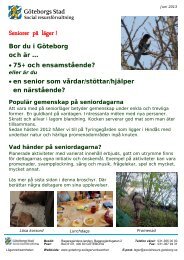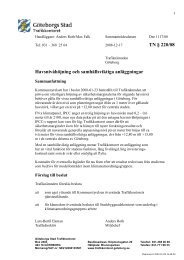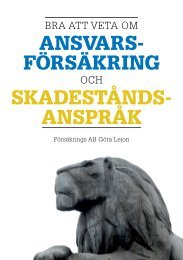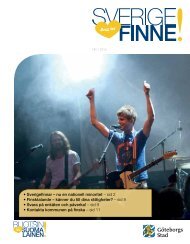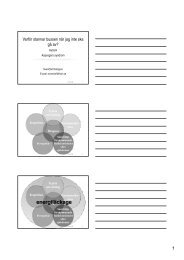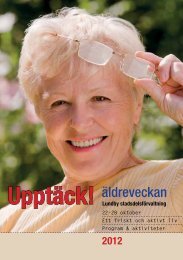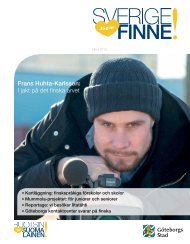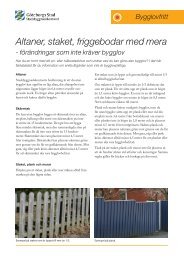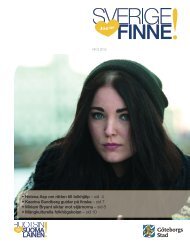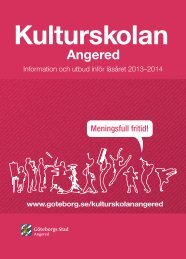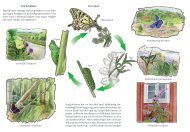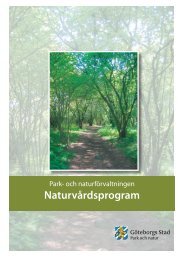Skiascope 1 som pdf - Göteborg
Skiascope 1 som pdf - Göteborg
Skiascope 1 som pdf - Göteborg
You also want an ePaper? Increase the reach of your titles
YUMPU automatically turns print PDFs into web optimized ePapers that Google loves.
Tyskland, Frankrike eller England, andra möjliga inspirationskällor<br />
för <strong>Göteborg</strong>s Museum och Lindholm, förefaller det ha förekommit,<br />
vare sig på museer eller tillfälliga utställningar. Inspirationen tycks<br />
snarare ha kommit öster ifrån. I Ryssland är det inte ovanligt att<br />
hänga ikoner över hörn, ett bruk <strong>som</strong> Kazimir Malevitj överförde<br />
till den moderna konstvärlden på 1910-talet. På ryska museer praktiserades<br />
hörnhängningar <strong>som</strong> ett mer intimt sätt att arrangera samlingarna.<br />
63 Också i Lindholms födelseland Finland, <strong>som</strong> ju vid tiden<br />
var ett ryskt storfurstendöme, hängde intendenterna på Ateneum<br />
målningar över hörn under 1800-talets senare hälft. 64<br />
Den sista stora förändringen av Konstavdelningen under Lindholms<br />
regim påbörjades 1902 när Pontus Fürstenberg. I ett testamente<br />
från 1898 hade han och hans hustru Göthilda testamenterat<br />
fastigheten i Brunnsparken och dess konstsamlingar till staden <strong>Göteborg</strong>.<br />
Testamentet tolkades <strong>som</strong> att det förelåg två alternativ: antingen<br />
behöll man konsten i det Fürstenbergska galleriet eller så flyttades<br />
den över till lokaler i <strong>Göteborg</strong>s Museum. En kommitté med bland<br />
andra Carl Lagerberg och Berndt Lindholm föreslog överflyttning av<br />
samlingarna. Två ledamöter reserverade sig, däribland konstnären<br />
Reinhold Callmander.<br />
Frågan föranledde en hätsk diskussion i konstvärlden. Prins Eugen,<br />
Richard Bergh, Anders Zorn, Georg och Hanna Pauli, Bruno Liljefors,<br />
Karl Nordström, Nils Kreuger och Eugène Jansson lämnade in<br />
en skriftlig protest, medan Carl Larsson, föreståndare för Valands<br />
konstskola, stödde beslutet. Larsson adjungerades till den beredning<br />
<strong>som</strong> hade ansvar för överflyttningen av konsten samt delar av inredningen.<br />
Nordström höll Lindholm för ansvarig och skriver i ett<br />
brev till Georg Pauli om hur resultatet av deras kamp nu hamnat i<br />
den föraktade museimannens händer: ”Och så att ge det i händer på<br />
denna inskränkta finndjävul med sitt hat mot den konst, <strong>som</strong> gjort<br />
honom själv överflödig och obetydlig.” 65<br />
Interiörerna och samlingarna installerades i två mindre rum<br />
på första våningen ( öster om trappan) samt två större salar på<br />
översta våningen i Wilsonska flygeln. Efter<strong>som</strong> det var frågan om<br />
existerande rum med givna mått fick interiörerna, inklusive Per<br />
Hasselbergs gesimsfigurer, anpassas till de nya förhållandena. Dessutom<br />
handlade det för Lindholm, kanske med Carl Larssons hjälp,<br />
om att sammanfoga konst både från det offentliga Fürstenbergska<br />
86<br />
•<br />
FIG. 10<br />
87<br />
sparse hanging. In the middle of the room is a generous sofa that allows<br />
views in all directions. A baldachin protects the visitor from direct light<br />
from the skylight. The paintings are hung on wire. The uppermost lean<br />
out from the wall, to make it easier to see them and to avoid reflections.<br />
Prince Eugen’s The Cloud hangs, a little surprisingly, diagonally over a<br />
corner. The artist had given the painting to the museum two years before.<br />
Several photographs of other rooms confirm that this corner hanging was<br />
not a one-off.<br />
Corner hanging may have been a way to exploit the room and the<br />
light to better effect. Skylights often leave the corners of a room in half<br />
shade. Diagonal accents were also a familiar element in the aesthetics of<br />
late nineteenth-century interior design. But the habit of hanging paintings<br />
over corners is not to be found in any other museum or exhibition<br />
in Sweden at this point. Nor, if it comes to that, in Germany, France or<br />
England, other possible sources of inspiration both for the museum and<br />
for Lindholm. Instead, the inspiration seems to have come from the east.<br />
In Russia it is not unusual to hang icons over a corner, a practice that<br />
Kazimir Malevitj passed on to the modern art world in the 1910s. In<br />
Russian museums, corner hanging was practised as a more intimate way<br />
of arranging collections. 63 Similarly, in Finland, the land of Lindholm’s<br />
birth, which at that time was a Russian Grand Duchy, the curators at the<br />
Ateneum in Helsinki hung paintings over corners in the latter part of the<br />
nineteenth century. 64<br />
The last significant change to the department of art in Lindholm’s<br />
day came in 1902, courtesy of Pontus Fürstenberg, who together with<br />
his wife Göthilda had bequeathed their mansion in Brunnsparken and<br />
its art collections to the city of Gothenburg back in 1898. The will was<br />
read as offering two alternatives : either the museum had to keep the<br />
art in the Fürstenberg gallery, or it had to be moved to premises in the<br />
Gothenburg Museum. A committee which included Carl Lagerberg and<br />
Berndt Lindholm proposed the transfer of the collections. Two committee<br />
members dissented, the artist Reinhold Callmander being one.<br />
The decision sparked a rancorous discussion in the art world. Prince<br />
Eugen, Richard Bergh, Anders Zorn, Georg and Hanna Pauli, Bruno<br />
Liljefors, Karl Nordström, Nils Kreuger, and Eugène Jansson all wrote in<br />
protest, while Carl Larsson, director of the Valand School of Art, supported<br />
the decision. Larsson was co-opted to the working committee responsible<br />
for the transfer of the art and <strong>som</strong>e of the furnishings. Nordström



